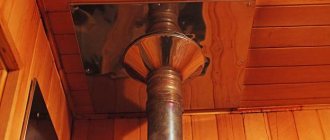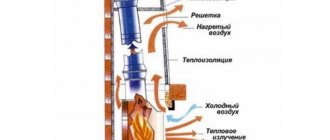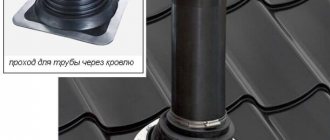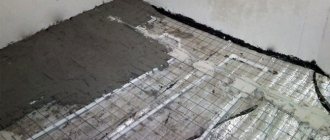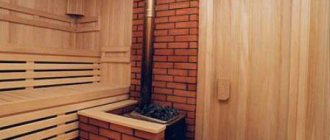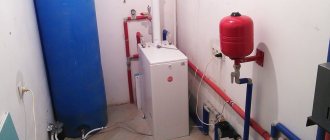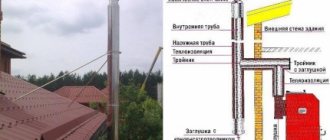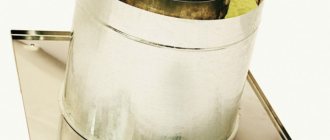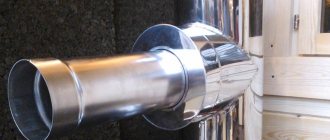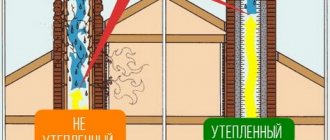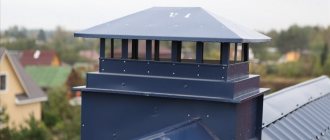What are asbestos cement pipes used for?
Asbestos cement is a durable fireproof material that combines the properties of asbestos and cement. Asbestos, or, as it is also called, mountain flax, is a group of silicate class materials that look like thin, durable threads. These threads are used as a frame into which other building materials are poured or laid. In the case of asbestos cement, such a building material is cement.
Asbestos gives strength to materials and protects them from fire. There are two types of asbestos: chrysotile and amphibole. The first is widespread in Russia, where there are asbestos deposits. This material has been used in construction for about five decades. Amphibole asbestos used to be common in European countries, but has now been banned due to its negative impact on human health.
This is interesting! Asbestos is a proven carcinogen, causing asbestosis and lung cancer in builders who worked with it. In a number of countries its use in construction is prohibited. In Russia, there are special safety standards when working with asbestos. When using products made from it, no health risks have been identified.
Asbestos-cement pipes are intended for those structures where there is water, steam or gas. They can withstand temperature fluctuations and, when installed correctly, last for many years.
Scope of application
Asbestos-cement pipes are used in various fields of construction. For example, they are used in the construction of sewage drains, both pressure and non-pressure. They often serve to supply water, both drinking and technical. Such pipes can also be used in the construction of a hot water supply system.
We recommend that you read: Features of cross-linked polyethylene for pipe production and their scope of application
In addition, asbestos-cement pipes are used in agriculture. There they are necessary when installing a reclamation system and drainage structures. In private houses, they are used to build wells, using them as casing pipes. In apartment buildings, there is another area of application for asbestos-cement pipes, in addition to water supply and sewage collection. These are garbage chute pipes. They are designed for both solid and liquid waste.
Due to the fire resistance of both asbestos itself and the structures that include it, such pipes are used for the construction of chimneys. However, there are several limitations in this application. In general, asbestos cement is used wherever there is a need for waterproofing, heat resistance, wear resistance and durability.
When are chimneys made from asbestos pipes used?
Most often, asbestos pipes are used as a temporary solution for a chimney. However, they cannot be used directly near the firebox. The part of the solid fuel chimney made of brick or metal adjacent to the stove serves not only to remove combustion products, but also for heat exchange inside the room, increasing the efficiency of the heating unit. The temperature of the exhaust gases there can significantly exceed the permissible limit of 300 oC. And only after passing through the channels of the convective zone and rising to the level of the ceiling with the attic, the escaping gases are cooled to a safe 200–250 degrees. There you can build up a chimney with an asbestos pipe, which is several times cheaper than a brick or any other pipe.
Asbestos pipes can be used in the upper part of the chimney, where combustion products enter already cooled
However, most modern thermal units, especially those running on natural gas, are characterized by high efficiency, which indicates the rational use of thermal energy. This applies to geysers, boilers and pyrolysis furnaces, the outlet temperature of which does not exceed 250 oC. Naturally, with such thermal devices it is quite logical to use inexpensive asbestos pipes. The only obstacle can be the increased ability of smoke channels to form condensation. Devices for its collection only partially solve the problem, so accelerated soot formation is inevitable here. The situation can only be corrected by regularly cleaning the smoke channel, which is extremely inconvenient during the heating season.
Another problem is the impossibility of installing inspection windows in asbestos pipes. For this reason, installation of such chimneys is possible only on straight sections.
Summarizing everything said above, we point out the circumstances that prevent the use of asbestos pipes for chimneys:
- High probability of destruction at temperatures above 300 oC.
- Fire hazard due to cracking of the chimney walls with combustion products escaping outside.
- Reduced draft force in the chimney due to the lack of heat capacity supporting it.
- Accumulation of condensation on the walls with increased soot formation.
- Inability to install inspection hatches in asbestos pipes.
- The requirement to install such products only in a vertical position.
- The need for regular inspection and cleaning of the chimney from soot.
When heated above 300 degrees, asbestos pipes burst and sometimes even explode
Baths, saunas and swimming pools
A chimney is a special channel for removing flue gases from a firebox, stove, fireplace or boiler, as well as for creating natural draft and supplying air to a heating unit for combustion.
All heating devices operate on different principles. Accordingly, everyone has different requirements for the arrangement of chimney systems. For some heating devices they use brick, for others - metal, for others - coaxial chimneys. All modern heating installations are provided with technical passports. They contain the necessary requirements for the design of chimney systems, the materials that must be used, and recommendations of specific chimney manufacturers or chimneys of our own production.
Often in small holiday villages you can find chimneys built using asbestos-cement pipes. They are used for various types of heating, including stove heating, which is a gross violation of fire safety rules. When installing a chimney system from an asbestos-cement pipe, it must be remembered that the maximum temperature of the flue gases should not exceed 300°C.
Let's talk about everything in order.
Content
Chimney classification
Heating technology is being improved and modernized every year. The efficiency of heat generators increases, fuel consumption decreases. But the exhaust of flue gases remains. For efficient and, most importantly, safe removal of flue gases, chimneys of various designs and from various materials are used.
A brick chimney is aesthetic, beautiful and durable. Well suited for stove heating with coal and wood. But as it turned out, for modern heating equipment it is not so durable. Modern gas and pyrolysis boilers operate in automatic on and off mode. This leads to cooling of the chimney and its subsequent heating and, accordingly, condensation. It saturates the masonry and corrodes the brick, and acidic water only speeds up the process. To avoid such an impact on the chimney masonry, it must be lined. Asbestos, polymer or other fire-resistant materials are used as inlays.
Ceramic chimney is the most progressive and technologically advanced chimney, but also the most expensive. It has high fire resistance up to 1200°C, is wear-resistant, easy to install and maintain. A large number of such systems are produced in Germany. Among them, it is necessary to note the chimneys of the Schiedel company. They provide a 30 year warranty on their products. The chimney is equipped with all the necessary accessories for servicing the chimney. Can be used for any heating devices, including liquid fuel boilers.
Chimneys made of stainless steel . Very often, choosing such a chimney is a game of roulette. Stainless steel undergoes irreversible changes at temperatures above 500°C and loses its mechanical properties. Can only be used for boilers that operate on gas; the operating temperature should not exceed 400°C. There is good stainless steel that can withstand flue gas temperatures up to 1000°C, but this is a completely different price.
Chimneys made of enameled steel - used for gas heat generators with a waste gas temperature of no more than 160°C. Enameled chimneys are made of steel st3. wall thickness – 0.5mm. Due to its coating, the dynamic resistance to flue gases is reduced.
A chimney made of asbestos-cement pipe is used as a temporary solution. An asbestos-cement pipe is used as the end of the chimney, first using brickwork or stainless steel. The asbestos-cement pipe has gained its consumer due to its low cost and ease of installation. Installing two or three meters of pipe or the same length of brickwork are not comparable things.
Coaxial chimney - or a pipe in a pipe, gas boiler manufacturers often equip their boilers with bottom chimneys. Sometimes such chimneys are used for fireplaces to warm the outside air.
Metal and asbestos chimneys are divided into single-walled or not insulated and double-walled - insulated. Stone wool with a basalt base is used as insulation in chimneys. A metal insulated chimney is also called a sandwich.
Requirements for the smoke exhaust system
The main parameters when choosing a chimney are the maximum temperature of the flue gases, resistance to soot combustion and cross-sectional area. The maximum temperature of flue gases is formed in stove heating when using coal and is about 400-500°C. For solid fuel boilers this parameter is slightly lower and will be up to 400°C, for gas and pyrolysis boilers – 140-250°C.
Asbestos chimney size
When selecting asbestos chimney pipes, you need to be guided by the following considerations:
- The use of this material is only possible for gas boilers and pyrolysis heating units, which are characterized by a low flue gas temperature. It should be taken into account that the smoke of pyrolysis furnaces is oversaturated with products that contribute to the formation of condensation, and therefore soot.
- The diameter of the asbestos chimney pipe should not be less than the outlet pipe of the heating unit.
- The total length of the chimney must be at least 5 meters, while the excess above the roof ridge must be at least 0.5 meters.
- Significantly exceeding this indicator will also lead to undesirable consequences due to a decrease in the speed of gas movement in the pipe. This will increase the amount of condensate formed.
The effectiveness of a chimney made of any material depends on its correct installation on the roof of the house
Manufacturing technology
When constructing a chimney from an asbestos-cement pipe, according to the standards, it is required to equip a foundation for the smoke exhaust duct, although in some cases the design of the asbestos purlin rests on the body of the heating device.
The technology for manufacturing a chimney from asbestos-cement products includes the following nuances:
- the length of the run from the grate to the outer end of the channel should be within 5-6 m;
- between the smoke exhaust structure and combustible elements of the roofing system, an interval of at least 1 m should be maintained;
- to connect the asbestos pipe and the heating device pipe, a connecting element 1 m long is used;
- You need high-quality insulation of the chimney line when crossing the floors. The thickness of the fluff layer varies according to the diameter of the pipe;
- the outer section of the run must be equipped with a heat-insulating layer;
- the height of the pipe on a flat roof should be at least 0.5 m above the level of the roof surface, and 1-1.5 m above the ridge if located on a pitched roof. If the height of the chimney structure exceeds 1.5 m, it is necessary to use braces or brackets to strengthen it.
It is recommended to use high-quality couplings for reliable connection of purlin units; it is worth remembering that materials with operating temperatures up to 1000°C are suitable for sealing.
Asbestos chimney installation
The chimney is installed in the following order:
- An asbestos pipe should never be removed directly from the kiln; it should rest on a concrete or brick base. The supply to the heating unit is made through a metal adapter. This part of the chimney is equipped with a flat damper or disc damper to regulate the draft by reducing the passage in the smoke exhaust channel.
- When installing a chimney, a container is provided in its lower part to collect condensate, which must be periodically emptied of black liquid with an unpleasant odor.
For asbestos pipes, plastic or metal condensate collectors of suitable diameter can be used - The upper end of the chimney must be equipped with a cap, and in the best case, with a deflector.
- At the junction with the chimney, a hatch is cut out in the ceiling, which is at least 15 centimeters larger than the dimensions of the pipe. A sheet metal damper is fixed to the ceiling below. Basalt wool is placed tightly into the resulting opening from above and covered with the same metal sheet on top.
When a pipe passes through the ceiling, a protective box of steel sheets is installed - Crossing the roofing pie is done in the same way. Only on the outside of the roofing you need to install an otter - a device to prevent water from entering through the pipe into the under-roof space. On the construction market it is easy to purchase a ready-made structure that matches the size of the pipe and the slope of the roof.
It should be remembered that chimneys made from asbestos pipes should absolutely not be used when installing heating in a bathhouse due to stoves with extremely high heating temperatures.
Fire safety
The requirements for a safe chimney installation do not differ from those for other systems:
- The passage of the smoke duct closer than 70 centimeters from the load-bearing structures of the building is not allowed.
- Chimneys cannot be painted with oil or enamel paint. If necessary, you can use lime or a special bitumen varnish.
- When a chimney passes through a wall, it must be finished with non-combustible material, and the passage itself must be sealed in the same way as a ceiling passage.
It should be remembered that the industry does not produce asbestos-cement pipes specifically for chimneys and the owner himself bears responsibility for their use in the heating system.
How to build an asbestos-cement pipe yourself?
During installation of an asbestos cement pipe, a piece broke off. Tell me, how can I now build up the broken piece myself?
There are a lot of very important points that require clarification.
Interested in beauty more than functionality of a pipe?
For example, a broken piece is the end point of the pipe.
You can do this: Clean the ends of the broken piece from dust, and perform the same operation on the pipe.
Then we degrease it and place it on “liquid nails.” It will hold on.
The same steps (remove dust), but without degreasing, place the broken piece on the tile adhesive.
Disadvantages of asbestos pipes
Despite its popularity in private construction, a chimney made from this material has many disadvantages.
Defects appear almost immediately or after some time, depending on factors such as the fuel used, climatic conditions and frequency of use of the boiler.
The quality of the pipeline installation also matters. Let's consider the characteristic disadvantages of asbestos-cement chimneys and the reasons for their occurrence.
Burnout and bursting
Initially, the products were developed for mass production for use in land reclamation, construction of sewers and low-pressure gas pipelines. The designers did not provide for their operation at high temperatures. Emphasis was placed on tightness and ease of installation of highways.
The basis of the material is cement, and it is a porous material. It absorbs creosote, which is a flammable material. With strong heating, the process of its combustion begins, as a result of which the structure of the walls changes, they become thinner and burn out.
What temperature can asbestos cement pipes withstand: their limit is + 300 ºС.
With further heating, the pressure of the air enclosed in the walls of the purlins increases. Products crack, burst and even explode.
Maintenance difficulties
The high strength of asbestos cement is a myth that many people want to believe. Working with links requires increased caution and accuracy. The lack of steel reinforcement makes them extremely brittle and brittle, regardless of diameter and type. And that's not all...
Chimney maintenance is associated with the following difficulties:
- the need for regular cleaning, since pipes literally attract soot;
- the inability to make inspection windows to reach hard-to-reach areas;
- sensitivity of products to shocks and loads;
- Frequent replacement of insulation, which is destroyed by chemically aggressive condensate.
Humidification of the pipeline is fraught with unpleasant consequences, both for communications and for the building as a whole.
Condensate
The main purpose of the products was the laying of open and underground water pipelines of various lengths. Asbestos-cement pipes are resistant to water, but quickly collapse when in contact with chemically active liquids. They are the ones that form on the surface of the chimney during the interaction of soot and condensate.
The aggressive solution flows onto the roof and is absorbed into its surface. As a result, stains, unpleasant odors and cracks appear. Watching the video below will help you understand the extent of the damage caused by condensation. This issue can be resolved with the help of properly carried out insulation.
How to increase safety when using asbestos pipes
One of the easiest ways to protect your home is to use asbestos chimney sandwich pipes, which are a closed system using an external casing and insulation.
The use of such structures provides many advantages. Insulating the outer part of the chimney can significantly reduce the amount of condensate formed. This makes it possible to significantly increase the service life of the asbestos-cement pipe. The outer side of the chimney, which is usually made of galvanized metal, coupled with a layer of thermal insulation material, makes the chimney structure as airtight as possible. This ensures that in the event of a seal burnout or significant cracks appearing, combustion products will not enter the room. A sandwich shell in which an asbestos-cement pipe is placed can provide additional protection for the structure of your home in the event that the material cannot withstand high temperatures and bursts. Also, the heat insulator will prevent small pieces of pipe from flying away that break off from the chimney when heated. In addition, sandwich pipes have a rather aesthetic appearance; they can easily fit into the overall design of the building.
Another important factor is protecting the health of the people living in the home. Scientists are still debating whether asbestos releases substances that poison the body. It is difficult to say how true this thesis is.
However, you can protect yourself, because an asbestos pipe enclosed in a casing made of metal and insulation will definitely not be able to release harmful substances into the room.
Sandwich-type structures are recognized as the most reliable way to make joints between a chimney pipe and ceilings. Their use eliminates the possibility of elements heating to critical levels that could lead to a fire.
Do not forget that a large number of shortcomings can be found in any material, even the most modern. It is necessary to be able to find the correct balance of advantages and disadvantages and, based on this indicator, make a decision on the choice of a particular material.
The disadvantages of asbestos-cement pipes can largely be compensated for by ease of installation and low cost. In addition, the manifestation of its shortcomings can be minimized. In conclusion, it can be noted that the use of a sandwich structure is far from the only way to “improve” asbestos-cement pipes. Similar DIY designs can play the same role.
Why were they popular in the past?
During Soviet times, there was an acute shortage of all types of building materials. Asbestos pipes were a real boon for private developers. The purlins met all safety standards, had no worthy alternative, and were distinguished by their strength, tightness and affordable price. The links were used in furnace making, arrangement of water supply systems, sewerage systems and construction of wells.
Over time, GOST requirements were replaced by TU. Changes were made to the production technology, which negatively affected the quality characteristics of the products.
Modern products are no longer designed to remove combustion products with temperatures above + 300 ºС.
They can only be used for a gas boiler, installed in the middle and end of the chimneys of saunas and baths. But, it is better to abandon this idea and use pipes made according to specifications for arranging low-pressure communications and protective structures for laying cables.
How to properly make a chimney from asbestos pipes
One of the reasons why the asbestos pipe has become widespread is that the installation of a homemade chimney from an asbestos pipe can be easily done with your own hands. During installation, fire safety requirements and standards, as well as current SNiPs, are taken into account.
Reliable fastening, heat and waterproofing are carried out, and also, if the pipe is cracked, smoke is prevented from entering the room. Below are the most common mistakes and solutions that take into account the characteristics of asbestos-cement pipes.
How to fix an asbestos-cement chimney
One of the most difficult things to do when installing a smoke exhaust system yourself is the accurate calculation and arrangement of external chimneys made of asbestos-cement pipes. Existing standards stipulate in detail what parameters a chimney pipe must meet in order to provide sufficient draft and be able to resist wind loads.
To secure the external chimney, special clamps and braces are used. When installing a free-standing pipe, or its part above the roof, adhere to the following recommendations:
- Calculate the diameter and height of the chimney from an asbestos pipe. The higher the chimney, the greater the wind load it experiences. To secure the pipe on the roof, raised above the ridge by more than 2 meters, roof braces are installed. The height is calculated depending on the distance of the chimney from the ridge of the building, the diameter according to the volume of the combustion chamber (recommended cross-section is at least 120 mm).
- A free-standing chimney is fixed to the wall every half meter using pipe clamps. To securely secure the pipe to the roof, a special roofing base is used. Sealing against leaks is mandatory.
- When installing an asbestos pipe in a brick channel, the pipe is securely fixed using special spacer fittings. The minimum distance between the pipes of a multi-channel chimney made of asbestos-cement pipes is at least 10 cm. A plate is installed on top of the structure, covering the channels from moisture. If you do not fix the asbestos pipe in a brick chimney, then over time the pipe at the joints will lose its tightness, which will result in the appearance of oxides and destruction of the walls.
- When passing through the roof and interfloor slabs, a fastening bracket made of asbestos cement is used. A distance of at least 10 cm is left between flammable materials and a very hot surface; a non-combustible chimney support is installed on the wooden floor.
- In a house made of aerated concrete blocks, it is not recommended to install free-standing chimneys. The wall to which the pipe is attached will not be able to withstand the wind load. The optimal solution would be to install an internal smoke exhaust system. If it is necessary to make an external connection, the use of guy wires is chosen as a method of attaching an asbestos-cement chimney pipe.
It is extremely important to secure the pipe to the roof to reduce the effects of wind loads. When heated, asbestos loses its strength. Any gust of wind can lead to loss of integrity of the chimney walls.
How to build up an asbestos-cement chimney pipe
The regulatory documents regulating the use of asbestos-cement pipes as chimneys, in particular SP 60.13330 (formerly SNiP 41-01-2003), indicate that asbestos chimney pipes are designed vertical. It is allowed to use asbestos-cement materials or prefabricated structures in which the top layer is made of stainless steel.
When laying chimneys, free-flow pipes are used. Stainless steel sleeves can be used as adapters when connecting to heating devices. To connect an asbestos pipe to a metal pipe, CAM type couplings are installed. The design of the adapter includes machined grooves, which ensures maximum tightness of the joints.
There are heat-resistant sealing gaskets on both sides of the coupling. To extend the pipe from the side of the asbestos chimney, remove the rubber band and fill the groove with a heat-resistant mixture to connect the asbestos-cement elements of the chimney pipe. If two asbestos pipes are connected, the sealing compound is used on both sides.
To connect asbestos-cement pipes to each other in a brick chimney, an inspection hole is made at the joining site, allowing installation work to be performed on site.
An adapter from an asbestos-cement pipe to a metal one compensates for the difference in heating and the ability of the material to expand. It is prohibited to use improvised means as a transition coupling.
How and with what to insulate an asbestos chimney
The asbestos-cement chimney pipe can withstand temperatures up to 300°C. At the same time, the material has high thermal conductivity and instantly transfers heat to the environment. The heating of the chimney surface is almost identical to the temperature of the exhaust flue gases. Surface insulation with non-flammable thermal insulation material is required for several reasons:
- Insulate the asbestos chimney pipe from wood or any other combustible wall sheathing.
- Reduce the amount of condensate produced and avoid freezing.
- Waterproof the pipe.
Modern insulation technologies can significantly reduce the volume of condensate in an asbestos pipe and significantly increase the service life of the chimney.
As practice shows, it is not enough to simply wrap an asbestos pipe with thermal insulation material in order to achieve good thermal insulation characteristics; work is carried out according to the following installation diagram:
- Choice of insulation - basalt wool or any other non-flammable thermal insulation is suitable for the work. It is better to choose a material that has a low water absorption coefficient. If necessary, it is possible to insulate with mineral wool insulation.
- Fixing the thermal insulation - the insulation is wound onto the pipe and secured using special clamps. Alternatively, tie wire can be used.
- Protective layer - insulation is carried out on top of the mineral insulation with foil insulation. A layer of foil protects the basalt wool from moisture and serves as additional protection against fire.
- Frame - the rules for installing and insulating asbestos-cement pipes provide for the use of a metal frame that protects a free-standing chimney or the outer part coming out of the roof. As an alternative, it is possible to use sandwich systems, with an outer layer of stainless steel and an inner layer of asbestos.
What are asbestos pipes needed for and how can they be used?
Initially, asbestos pipes were produced for agricultural needs in order to carry out land reclamation. This type of product became widespread due to the low cost of production during the Soviet Union. In the 90s of the last century, private developers began to adapt asbestos-cement pipes for chimneys. The following logic explains this:
- The products were still affordable;
- The material did not have the ability to ignite;
- The market offered channels of different diameters;
- It was easier and faster to build a chimney from an asbestos structure than, for example, to lay it out of brick.
Since asbestos was not technologically intended for use in heating systems, it should be used only with great reservations and knowledge of its weaknesses. Where it is definitely possible to install pipes without the risk of accidents, destruction, or harm to health:
- As air ducts;
- Ventilation systems;
- Channels for laying various communications;
- Storm water drainage systems;
- As sewer lines.
It should be borne in mind that the material asbestos itself is a hazardous substance. In the European Union countries, the use of products based on it is prohibited or allowed with strict restrictions, so it is necessary to use asbestos-cement pipe in places where it will not be subject to severe destruction, or additionally treat it with sealing coatings.
Should asbestos pipes be used for chimneys?
But that is not all. Like brick, asbestos begins to absorb condensation. Having become saturated with it, he begins to transmit it to the entire structure. Hence the stains on the walls and the unpleasant smell. Continued use of such a system will lead to complete destruction of the chimney.
Insulation as a panacea
Draw conclusions about what is cheaper and more convenient for you.
As a rule, chimney insulation, when using boilers with high efficiency, does not give the desired result. However, if you still insulate the chimney, it will last a little longer.
The result of insulation
Should I use asbestos-cement pipes for the chimney?
You should not listen to the advice of visiting “experts” from nearby countries: “my mother-in-law has had an asbestos pipe for thirty years and, most likely, it will outlive her mother-in-law.” It's probably true! But there is a small addition: the mother-in-law does not have a modern, economical boiler installed, but a clay hut from the beginning of the last century.
Step-by-step insulation technology
Due to the fact that chimneys come in different types and designs, we will describe how to properly insulate a chimney pipe made of brick, asbestos cement and steel.
Chimneys made of asbestos cement
Asbestos cement pipe
To understand how to insulate a chimney from an asbestos pipe, we will analyze the entire procedure step by step, following the recommendations of professional builders:
First, you need to thoroughly clean the work area from dust and dirt; The next step is to make a special folding casing for the insulation (made from galvanized iron)
When determining its parameters, it should be taken into account that at least 6 cm should remain between the pipe and the iron for insulation; Pay attention to the fact that a casing assembled from several parts is put on the asbestos pipe, and each of them should not exceed 1.5 m; First of all, you should secure the lower part of the casing and carefully fill it with sealant. Then, the second part is put on and the procedure is repeated. This design must run along the entire length of the asbestos pipe.
This design must run along the entire length of the asbestos pipe.
Thermal insulation diagram from a home craftsman
This is what an asbestos chimney with a casing looks like
Often, many cottage owners do without a casing. The pipe is simply wrapped in a roll of mineral wool and secured with staples. In order for this method of insulation to become truly reliable, several layers should be wound.
Steel chimneys
So, we seem to have sorted out the asbestos pipes, now let’s see how to insulate the metal chimney pipe. In general, many manufacturers of building materials produce ready-made chimneys made of stainless steel. The design is quite simple and consists of only two pipes of different diameters.
How to insulate a metal chimney? To do this, take a pipe of smaller diameter and insert it into a pipe of larger diameter. Then, the remaining space between the pipes is filled with any of the above types of insulation. If you are interested in modern materials, then we can recommend basalt chimney insulation, which in its structure resembles mineral wool, but is much more practical and durable.
Thermal insulation of a steel chimney
In principle, it is much easier to insulate an iron pipe than an asbestos pipe, so there should be no problems here.
Brick chimney
Brick chimney
Insulating a brick chimney is perhaps the most complex type of all presented in this article. Now we will present several options, from which everyone will choose for themselves how to insulate a brick chimney:
Plastering method. To do this, you will need to attach a reinforced mesh to the chimney. Then prepare a solution of lime, slag and a small portion of cement. Spread the resulting solution over the entire surface of the chimney and level it (all work is done in one layer, which should be at least 3 cm).
When the solution dries, you can add a few more layers and immediately cover up the resulting cracks. To give an attractive appearance, the pipe can be whitewashed or painted in the future.
Thermal insulation diagram of a brick chimney
Insulation with mineral wool. To do this, you will need to take a roll of basalt wool and cut it into pieces that correspond to the dimensions of the chimney area. Then, the insulation is glued to the pipe using tape. The last step of the work is to lay insulation (for example, Rocklight) with a second layer of bricks or asbestos-cement slabs.
The process of thermal insulation of a chimney with mineral wool
Good luck!
Prices for asbestos pipes
| Name (Diameter, Length, mm) | Unit change | Pipe weight | Cost (pieces), rubles |
| per piece | |||
| Asbestos-cement free-pressure pipes GOST 1839-80/31416-2009 | |||
| Gravity pipe 100 (3950) | PC. | 20,1 | 280 rub. Buy |
| Gravity pipe 150 (3950) | PC. | 27,2 | 472 rub. Buy |
| Gravity pipe 200 (3950) | PC. | 57,2 | 985 rub. Buy |
| Gravity pipe 200 (5000) | PC. | 72,3 | 1160 rub. Buy |
| Gravity pipe 250 (5000) | PC. | 91 | 1670 rub. Buy |
| Gravity pipe 300 (5000) | PC. | 114 | 2370 rub. Buy |
| Gravity pipe 350 (5000) | PC. | 154 | 3400 rub. Buy |
| Gravity pipe 400 (5000) | PC. | 237 | 3620 rub. Buy |
| Gravity pipe 500 (5000) | PC. | 360 | 7060 rub. Buy |
| Asbestos-cement pressure pipes VT-6 GOST 539-80/31416-2009 | |||
| Pressure pipe VT-6 100 (3950) | PC. | 30,8 | 650 rub. Buy |
| Pressure pipe VT-6 150 (3950) | PC. | 51 | 1060 rub. Buy |
| Pressure pipe VT-6 200 (5000) | PC. | 124 | 1750 rub. Buy |
| Pressure pipe VT-6 250 (5000) | PC. | 151 | 3200 rub. Buy |
| Pressure pipe VT-6 300 (5000) | PC. | 199 | 3400 rub. Buy |
| Pressure pipe VT-6 400 (5000) | PC. | 334 | 5620 rub. Buy |
| Pressure pipe VT-6 500 (5000) | PC. | 537 | 10180 rub. Buy |
| Asbestos-cement pressure pipes VT-9 GOST 539-80/31416-2009 | |||
| Pressure pipe VT-9 100 (3950) | PC. | 45,9 | 750 rub. Buy |
| Pressure pipe VT-9 150 (3950) | PC. | 67 | 1060 rub. Buy |
| Pressure pipe VT-9 200 (5000) | PC. | 142 | 2020 Buy |
| Pressure pipe VT-9 250 (5000) | PC. | 169 | 3670 rub. Buy |
| Pressure pipe VT-9 300 (5000) | PC. | 217 | 3990 Buy |
| Pressure pipe VT-9 400 (5000) | PC. | 390,5 | 6800 rub. Buy |
| Pressure pipe VT-9 500 (5000) | PC. | 623 | 10470 rub. Buy |
If we talk about prices for asbestos pipes, they depend on what parameters need to be purchased. Diameter, length and weight make up the price of such materials.
